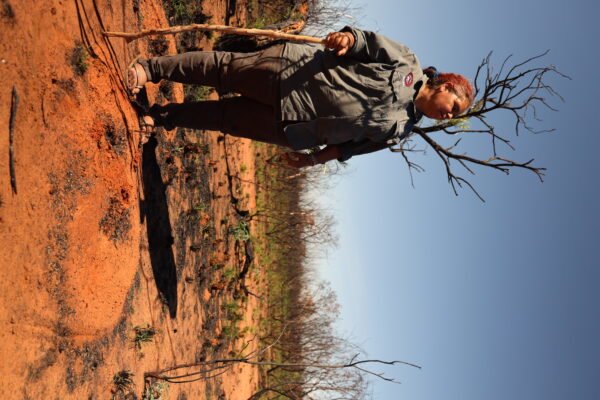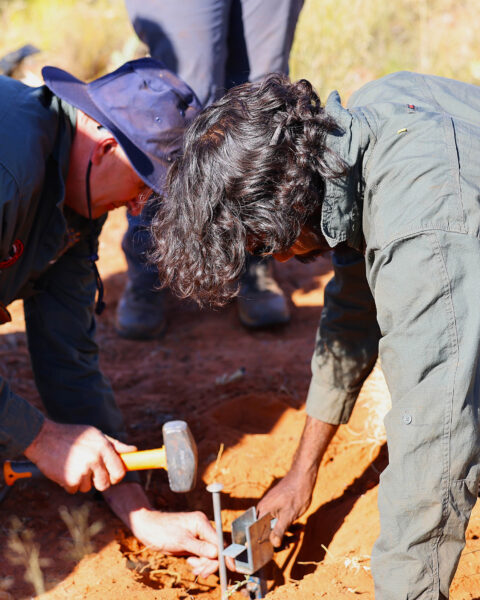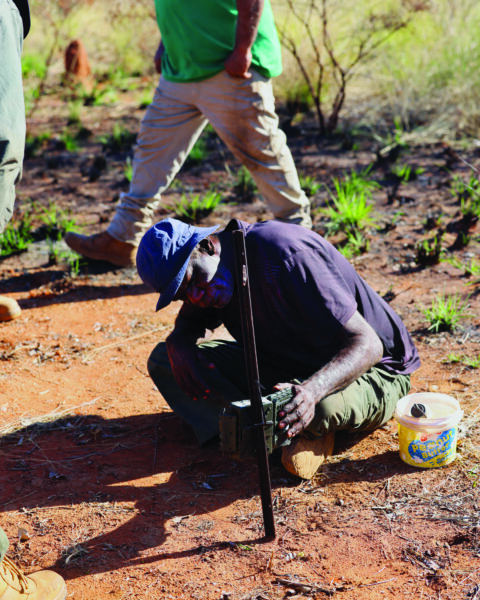A Land Rights News article.

Combining Aboriginal ways of knowing with scientific monitoring of bilbies makes for better research.
Lajamanu traditional owners and rangers are helping a researcher find bilby tracks, identify their desert environments and threats and develop conservation strategies.
Dr Hayley Geyle relies on the lead ranger of the Central Land Council's North Tanami Rangers, Helen Wilson, and her community to find the shy nocturnal creatures. Together, they learn more about the size of their families and develop strategies to protect bilbies from cats and foxes.
"My work would not have been possible without traditional owners and rangers. They've taught me so much about how to track animals across this landscape. They have deep knowledge of bilbies-where they live, how they behave and what's putting them at risk," she said.
Studying bilbies over the past four years with Yapa has helped the researcher from Territory Natural Resource Management and Charles Darwin University gain clearer and deeper knowledge.
"It's given me a whole new understanding of how these animals might be interacting across the landscape," Dr Geyle said.
"It's been really great to learn from elders and rangers and to bring that knowledge into our science. It's definitely led to much better outcomes." For example when looking for bilby poo, also known as kuna or scats.
"A study we published together showed that we were able to find a lot more bilby scats when we based our surveys on local tracking knowledge, compared to standard scientific methods."
Ms Wilson said the traditional owners are keen to be part of the research.
"The community come out with us when we do the surveys. They really like to learn. It creates excitement."
She said Yapa liked working with Dr Geyle because she listens to them. "We make a good team."

The two-way knowledge sharing gained national attention with Ms Wilson and Dr Geyle winning the 2024 Bush Heritage Australia 'Right Way' Science award at the Ecological Society Australia conference.
"I feel happy and pleased because I am doing my work for my people, the community and country," said Ms Wilson.
Before colonisation, bilbies lived across most of Australia. Today, they're found in less than a quarter of their former range, mainly because of feral predators and changes to how country is burned and looked after.
In July, North Tanami rangers Ms Wilson, Travis Penn and Kealyn Kelly and traditional owner Silas James took Dr Geyle to known bilby sites on the Northern Tanami Indigenous Protected Area to test a method for controlling foxes that doesn't harm dingoes.
The team checked on spring-loaded baiting devices and the motion-sensor cameras they had deployed earlier to monitor how foxes, cats and other animals interacted with the devices. They also surveyed track plots and flew drones to look for signs of bilbies and other animals. The cameras confirmed what traditional owners already knew: foxes are very busy in the area.
The team tested the baiting devices with dried meat but without the poison capsule they can release when triggered by foxes.
It consulted elders throughout the process to ensure dingoes, which are sacred to the area, would not be harmed. The trap's design included a special collar that stop dingoes from triggering the devices.
"Next, we'll go through the footage with the rangers and traditional owners and have a yarn about whether this method is a good fit for the Northern Tanami," said Dr Geyle.
The rangers showed how good they are at finding signs of bilbies from a moving car. Driving at 40 kilometres per hour they asked to pull over every time they spotted new burrows metres from the track. Ms Wilson collected bilby poo while Dr Geyle recorded the locations on her phone app.
The team expanded the search by scanning hard-to-reach areas with drones. Then the workers searched the ground where the drone footage showed signs of bilbies.
"There's a few things I've learned, like recording the data on the iPad and the phone," Mr Kelly said. "The cameras also, I'm trying to figure out how they work and everything, and trying to put them in spots where they can't get destroyed by fire or some other animal."
He said Yapa ways are front and centre of the work.
"Some parts where we do the surveys, some women or some men aren't allowed to go on that site… so we just work as a team you know, try to divide the group and try to record as much data as we can."
Dr Geyle said the work the team produced together was strong, both from a scientific point of view and from a cultural point of view. "It's really helped us collect better data, by working with people who know the land the best and can guide us to areas where bilbies or foxes are likely to be," she said.
"More than that, it reflects a whole different world view, one that is deeply connected to country and built on generations of lived experience. This perspective brings knowledge, values and ways of seeing that are just as important as the science. Without it, we'd be missing a big part of the picture."







